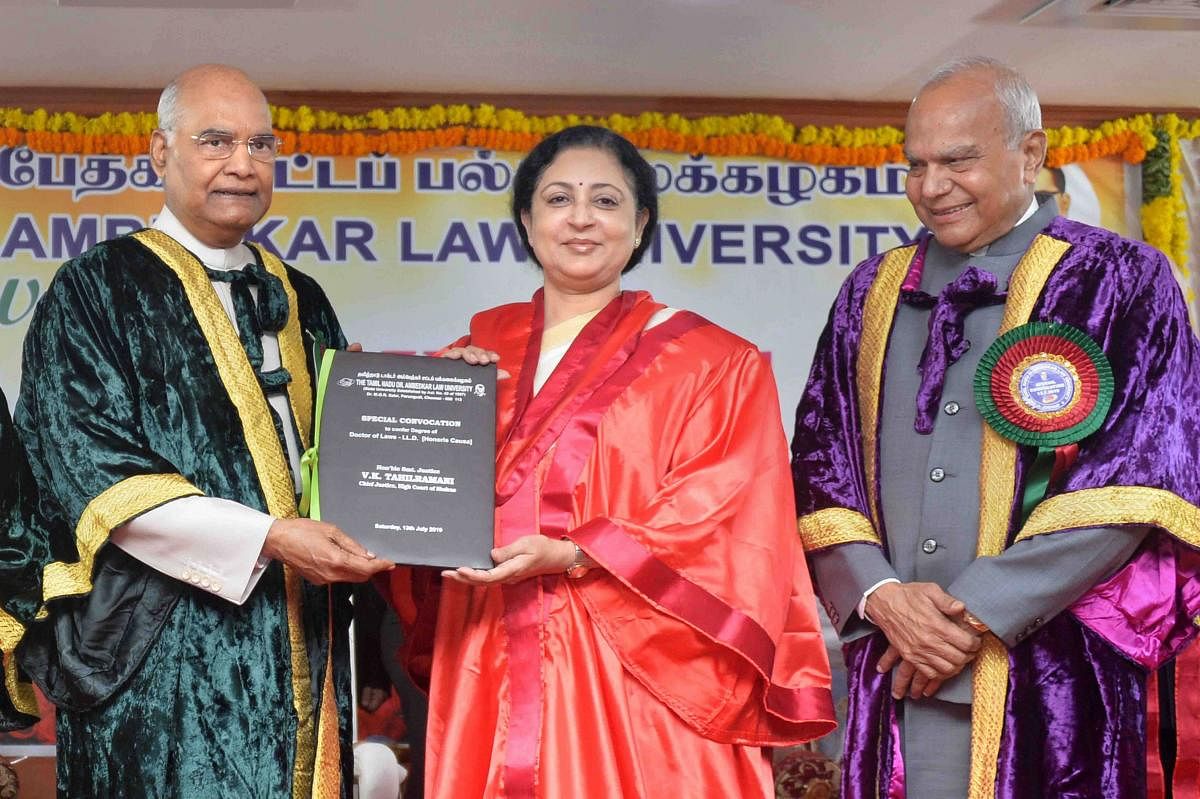
Madras High Court Chief Justice V K Tahilramani tendered her resignation following the Supreme Court collegium’s refusal to reconsider its decision to transfer her to Meghalaya High Court. In its published decision, the collegium mentioned that the decision to transfer Justice Tahilramani had been taken “in the interest of better administration of justice.” In over 40 transfers of high court judges in the last two years, the collegium has used the exact same phrase to justify its decisions. Some reports indicate the possibility that Justice Tahilramani was transferred as a punishment for refusing to facilitate the appointment of some lawyers as high court judges despite being nudged by senior judges in the Supreme Court.
Article 222 of the Constitution authorises the President to transfer judges of the high courts in consultation with the Chief Justice of India. The Constitution does not lay down any kind of guideline as to the reasons for which a judge can be transferred. The Supreme Court has on certain occasions ruled on this issue and has provided some broad parameters.
It is important to note that the transfer of a high court judge is a rare occurrence. In many government services and departments, transfers of personnel is a routine matter for officers of even the highest cadre. However, in relation to judges of the high courts, it is perfectly possible and is indeed the case, that most of the judges are not transferred even once in their career. This rarity makes the transfer of a judge a sensitive issue. There are legitimate concerns that the power of transfer can be used to penalise judges delivering inconvenient decisions. The Supreme Court in the Sankalchand Sheth case (1978) has noted that during Emergency, the government had transferred as many as 16 high court judges as a way of punishment.
Concerns regarding the abuse of the power of transfer has led the Supreme Court to rule in multiple cases (Sankalchand 1978, SP Gupta 1982, SCORA 1993) that the power to transfer judges can only be used in public interest and to promote better administration of justice. The court has emphasised that a judge is not supposed to be transferred as a way of being punished. However, the court has also clarified that the consent of the judge is not necessary for him/her to be transferred. Since 1993, the decision regarding transfer of judges is taken by the collegium headed by the Chief Justice of India.
The gist of these judicial decisions is that when a judge is transferred, we are now told that the decision has been taken in public interest or for better administration of justice. A single line explanation (in the interest of better administration of justice) is appended to the decision. Unfortunately, we are never told the exact meaning of these terms. We often have no idea how exactly public interest is served when a judge is transferred from Karnataka to Odisha or from Bihar to Kerala. We do not know why justice is better administered due to the transfer of one particular judge, and not of another. For example, we do not know how public interest was served when a chief justice of the Karnataka high court who was facing serious allegations of corruption was transferred to the Sikkim high court.
In a more transparent regime, there would be a clear and transparent policy on the transfer of high court judges. It could be based on the availability of expertise in specific areas of law at a given point of time in a given high court; it could be based on the idea of promoting a diverse court in each state. Back in 1981, the government had juggled with the idea of ensuring that one-third of the judges in each high court should be from other states. While the government used the pretext of ‘national integration’ and there were serious concerns regarding its actual agenda, the idea in principle is not a bad one. Having judges from outside the state can be a useful way to counter the nexus of local affiliations.
As of now, we have no clarity on the framework of transfers. There is no policy on how many times a judge can be transferred in his/her career. There is no policy on the time gap between each transfer if a judge is transferred multiple times. There is no clarity on how the transfer location is finalised. We do not know how much experience a judge must have before he/she is transferred. There is no proper explanation on how a transfer contributes to the better administration of justice – does it contribute to the better administration of justice in the high court to which a judge is transferred or in the high court from which he/she is transferred? A settled and documented policy will allay significant concerns in this respect.
Unlike in other federal countries (United States), a high court in India is not a singular entity. Instead, all the high courts constitute a unified judicial structure. It is not constitutionally possible for a judge in the State Supreme Court of California to be transferred to the State Supreme Court of Texas. The Indian Constitution has imagined high court judges as an all-India cadre and has thus enabled fluidity of movement amongst the high courts. Thus, a transfer in itself should not be treated as a snub by the judges. But that can happen only when transfers happen pursuant to clear institutional policy and not in terms of individualised actions.
The government does not have the power to shift judges around anymore the way it could before the establishment of the collegium. However, while the seat of power has changed, the concerns remain. All that we have to show in the name of progressive transparency is one additional line in the transfer order; “in the interest of better administration of justice.”
(The writer is a Fulbright Post-Doctoral Research Scholar, Harvard Law School)